- Home
- Michael Pollan
Food Rules
Food Rules Read online
Table of Contents
PENGUIN BOOKS
Title Page
Copyright Page
Dedication
Introduction
PART I - What should I eat?
Chapter 1 - Eat food.
Chapter 2 - Don’t eat anything your great-grandmother wouldn’t recognize as food.
Chapter 3 - Avoid food products containing ingredients that no ordinary human ...
Chapter 4 - Avoid food products that contain high-fructose corn syrup.
Chapter 5 - Avoid foods that have some form of sugar (or sweetener) listed ...
Chapter 6 - Avoid food products that contain more than five ingredients.
Chapter 7 - Avoid food products containing ingredients that a third-grader ...
Chapter 8 - Avoid food products that make health claims.
Chapter 9 - Avoid food products with the wordoid “lite” or the terms “low-fat” ...
Chapter 10 - Avoid foods that are pretending to be something they are not.
Chapter 11 - Avoid foods you see advertised on television.
Chapter 12 - Shop the peripheries of the supermarket and stay out of the middle.
Chapter 13 - Eat only foods that will eventually rot.
Chapter 14 - Eat foods made from ingredients that you can picture in their raw ...
Chapter 15 - Get out of the supermarket whenever you can.
Chapter 16 - Buy your snacks at the farmers’ market.
Chapter 17 - Eat only foods that have been cooked by humans.
Chapter 18 - Don’t ingest foods made in places where everyone is required to ...
Chapter 19 - If it came from a plant, eat it; if it was made in a plant, don’t.
Chapter 20 - It’s not food if it arrived through the window of your car.
Chapter 21 - It’s not food if it’s called by the same name in every language. ...
PART II - What kind of food should I eat?
Chapter 22 - Eat mostly plants, especially leaves.
Chapter 23 - Treat meat as a flavoring or special occasion food.
Chapter 24 - “Eating what stands on one leg [mushrooms and plant foods] is ...
Chapter 25 - Eat your colors.
Chapter 26 - Drink the spinach water.
Chapter 27 - Eat animals that have themselves eaten well.
Chapter 28 - If you have the space, buy a freezer.
Chapter 29 - Eat like an omnivore.
Chapter 30 - Eat well-grown food from healthy soil.
Chapter 31 - Eat wild foods when you can.
Chapter 32 - Don’t overlook the oily little fishes.
Chapter 33 - Eat some foods that have been predigested by bacteria or fungi.
Chapter 34 - Sweeten and salt your food yourself.
Chapter 35 - Eat sweet foods as you find them in nature.
Chapter 36 - Don’t eat breakfast cereals that change the color of the milk.
Chapter 37 - “The whiter the bread, the sooner you’ll be dead.”
Chapter 38 - Favor the kinds of oils and grains that have traditionally been stone-ground.
Chapter 39 - Eat all the junk food you want as long as you cook it yourself.
Chapter 40 - Be the kind of person who takes supplements—then skip the supplements.
Chapter 41 - Eat more like the French. Or the Japanese. Or the Italians. Or the Greeks.
Chapter 42 - Regard nontraditional foods with skepticism.
Chapter 43 - Have a glass of wine with dinner.
PART III - How should I eat?
Chapter 44 - Pay more, eat less.
Chapter 45 - . . . Eat less.
Chapter 46 - Stop eating before you’re full.
Chapter 47 - Eat when you are hungry, not when you are bored.
Chapter 48 - Consult your gut.
Chapter 49 - Eat slowly.
Chapter 50 - “The banquet is in the first bite.”
Chapter 51 - Spend as much time enjoying the meal as it took to prepare it.
Chapter 52 - Buy smaller plates and glasses.
Chapter 53 - Serve a proper portion and don’t go back for seconds.
Chapter 54 - “Breakfast like a king, lunch like a prince, dinner like a pauper.”
Chapter 55 - Eat meals.
Chapter 56 - Limit your snacks to unprocessed plant foods.
Chapter 57 - Don’t get your fuel from the same place your car does.
Chapter 58 - Do all your eating at a table.
Chapter 59 - Try not to eat alone.
Chapter 60 - Treat treats as treats.
Chapter 61 - Leave something on your plate.
Chapter 62 - Plant a vegetable garden if you have the space, a window box if ...
Chapter 63 - Cook.
Chapter 64 - Break the rules once in a while.
Acknowledgements
PENGUIN BOOKS
FOOD RULES
MICHAEL POLLAN is the author of five previous books, including In Defense of Food, a number one New York Times bestseller, and The Omnivore’s Dilemma, which was named one of the ten best books of the year by both the New York Times and the Washington Post. Both books won the James Beard Award. A longtime contributor to the New York Times Magazine, he is also the Knight Professor of Journalism at the University of California at Berkeley.
PENGUIN BOOKS
Published by the Penguin Group
Penguin Group (USA) Inc., 375 Hudson Street,
New York, New York 10014, U.S.A.
Penguin Group (Canada), 90 Eglinton Avenue East, Suite 700, Toronto,
Ontario, Canada M4P 2Y3 (a division of Pearson Penguin Canada Inc.)
Penguin Books Ltd, 80 Strand, London WC2R 0RL, England
Penguin Ireland, 25 St Stephen’s Green, Dublin 2, Ireland
(a division of Penguin Books Ltd)
Penguin Group (Australia), 250 Camberwell Road, Camberwell,
Victoria 3124, Australia (a division of Pearson Australia Group Pty Ltd)
Penguin Books India Pvt Ltd, 11 Community Centre,
Panchsheel Park, New Delhi - 110 017, India
Penguin Group (NZ), 67 Apollo Drive, Rosedale, North Shore 0632,
New Zealand (a division of Pearson New Zealand Ltd)
Penguin Books (South Asfrica) (Pty) Ltd, 24 Sturdee Avenue,
Rosebank, Johannesburg 2196, South Africa
Penguin Books Ltd, Registered Offices:
80 Strand, London WC2R 0RL, England
First published in Penguin Books 2009
Copyright © Michael Pollan, 2009
All rights reserved
eISBN : 978-1-101-16316-0
The scanning, uploading and distribution of this book via the Internet or via any other means without the permission of the publisher is illegal and punishable by law. Please purchase only authorized electronic editions, and do not participate in or encourage electronic piracy of copyrighted materials. Your support of the author’s rights is appreciated.
http://us.penguingroup.com
For my mother,
who always knew butter was better for you
than margarine
Introduction
Eating in our time has gotten complicated—needlessly so, in my opinion. I will get to the “needlessly” part in a moment, but consider first the complexity that now attends this most basic of creaturely activities. Most of us have come to rely on experts of one kind or another to tell us how to eat—doctors and diet books, media accounts of the latest findings in nutritional science, government advisories and food pyramids, the proliferating health claims on food packages. We may not always heed these experts’ advice, but their voices are in our heads every time we order from a menu or wheel down the aisle in the supermarket. Also in our heads today resides an astonishing amoun
t of biochemistry. How odd is it that everybody now has at least a passing acquaintance with words like “antioxidant,” “saturated fat,” “omega-3 fatty acids,” “carbohydrates,” “polyphenols,” “folic acid,” “gluten,” and “probiotics”? It’s gotten to the point where we don’t see foods anymore but instead look right through them to the nutrients (good and bad) they contain, and of course to the calories—all these invisible qualities in our food that, properly understood, supposedly hold the secret to eating well.
But for all the scientific and pseudoscientific food baggage we’ve taken on in recent years, we still don’t know what we should be eating. Should we worry more about the fats or the carbohydrates? Then what about the “good” fats? Or the “bad” carbohydrates, like high-fructose corn syrup? How much should we be worrying about gluten? What’s the deal with artificial sweeteners? Is it really true that this breakfast cereal will improve my son’s focus at school or that other cereal will protect me from a heart attack? And when did eating a bowl of breakfast cereal become a therapeutic procedure?
A few years ago, feeling as confused as everyone else, I set out to get to the bottom of a simple question: What should I eat? What do we really know about the links between our diet and our health? I’m not a nutrition expert or a scientist, just a curious journalist hoping to answer a straightforward question for myself and my family.
Most of the time when I embark on such an investigation, it quickly becomes clear that matters are much more complicated and ambiguous—several shades grayer—than I thought going in. Not this time. The deeper I delved into the confused and confusing thicket of nutritional science, sorting through the long-running fats versus carbs wars, the fiber skirmishes and the raging dietary supplement debates, the simpler the picture gradually became. I learned that in fact science knows a lot less about nutrition than you would expect—that in fact nutrition science is, to put it charitably, a very young science. It’s still trying to figure out exactly what happens in your body when you sip a soda, or what is going on deep in the soul of a carrot to make it so good for you, or why in the world you have so many neurons—brain cells!—in your stomach, of all places. It’s a fascinating subject, and someday the field may produce definitive answers to the nutritional questions that concern us, but—as nutritionists themselves will tell you—they’re not there yet. Not even close. Nutrition science, which after all only got started less than two hundred years ago, is today approximately where surgery was in the year 1650—very promising, and very interesting to watch, but are you ready to let them operate on you? I think I’ll wait awhile.
But if I’ve learned volumes about all we don’t know about nutrition, I’ve also learned a small number of very important things we do know about food and health. This is what I meant when I said the picture got simpler the deeper I went.
There are basically two important things you need to know about the links between diet and health, two facts that are not in dispute. All the contending parties in the nutrition wars agree on them. And, even more important for our purposes, these facts are sturdy enough that we can build a sensible diet upon them. Here they are:
FACT 1. Populations that eat a so-called Western diet—generally defined as a diet consisting of lots of processed foods and meat, lots of added fat and sugar, lots of refined grains, lots of everything except vegetables, fruits, and whole grains—invariably suffer from high rates of the so-called Western diseases: obesity, type 2 diabetes, cardiovascular disease, and cancer. Virtually all of the obesity and type 2 diabetes, 80 percent of the cardiovascular disease, and more than a third of all cancers can be linked to this diet. Four of the top ten killers in America are chronic diseases linked to this diet. The arguments in nutritional science are not about this well-established link; rather, they are all about identifying the culprit nutrient in the Western diet that might be responsible for chronic diseases. Is it the saturated fat or the refined carbohydrates or the lack of fiber or the transfats or omega-6 fatty acids—or what? The point is that, as eaters (if not as scientists), we know all we need to know to act: This diet, for whatever reason, is the problem.
FACT 2. Populations eating a remarkably wide range of traditional diets generally don’t suffer from these chronic diseases. These diets run the gamut from ones very high in fat (the Inuit in Greenland subsist largely on seal blubber) to ones high in carbohydrate (Central American Indians subsist largely on maize and beans) to ones very high in protein (Masai tribesmen in Africa subsist chiefly on cattle blood, meat, and milk), to cite three rather extreme examples. But much the same holds true for more mixed traditional diets. What this suggests is that there is no single ideal human diet but that the human omnivore is exquisitely adapted to a wide range of different foods and a variety of different diets. Except, that is, for one: the relatively new (in evolutionary terms) Western diet that most of us now are eating. What an extraordinary achievement for a civilization: to have developed the one diet that reliably makes its people sick! (While it is true that we generally live longer than people used to, or than people in some traditional cultures do, most of our added years owe to gains in infant mortality and child health, not diet.)
There is actually a third, very hopeful fact that flows from these two: People who get off the Western diet see dramatic improvements in their health. We have good research to suggest that the effects of the Western diet can be rolled back, and relatively quickly.1 In one analysis, a typical American population that departed even modestly from the Western diet (and lifestyle) could reduce its chances of getting coronary heart disease by 80 percent, its chances of type 2 diabetes by 90 percent, and its chances of colon cancer by 70 percent.2
Yet, oddly enough, these two (or three) sturdy facts are not the center of our nutritional research or, for that matter, our public health campaigns around diet. Instead, the focus is on identifying the evil nutrient in the Western diet so that food manufacturers might tweak their products, thereby leaving the diet undisturbed, or so that pharmaceutical makers might develop and sell us an antidote for it. Why? Well, there’s a lot of money in the Western diet. The more you process any food, the more profitable it becomes. The healthcare industry makes more money treating chronic diseases (which account for three quarters of the $2 trillion plus we spend each year on health care in this country) than preventing them. So we ignore the elephant in the room and focus instead on good and evil nutrients, the identities of which seem to change with every new study. But for the Nutritional Industrial Complex this uncertainty is not necessarily a problem, because confusion too is good business: The nutrition experts become indispensable; the food manufacturers can reengineer their products (and health claims) to reflect the latest findings, and those of us in the media who follow these issues have a constant stream of new food and health stories to report. Everyone wins. Except, that is, for us eaters.
As a journalist I fully appreciate the value of widespread public confusion: We’re in the explanation business, and if the answers to the questions we explore got too simple, we’d be out of work. Indeed, I had a deeply unsettling moment when, after spending a couple of years researching nutrition for my last book, In Defense of Food, I realized that the answer to the supposedly incredibly complicated question of what we should eat wasn’t so complicated after all, and in fact could be boiled down to just seven words:Eat food. Not too much. Mostly plants.
This was the bottom line, and it was satisfying to have found it, a piece of hard ground deep down at the bottom of the swamp of nutrition science: seven words of plain English, no biochemistry degree required. But it was also somewhat alarming, because my publisher was expecting a few thousand more words than that. Fortunately for both of us, I realized that the story of how so simple a question as what to eat had ever gotten so complicated was one worth telling, and that became the focus of that book.
The focus of this book is very different. It is much less about theory, history, and science than it is about our daily lives and practice. In this
short, radically pared-down book, I unpack those seven words of advice into a comprehensive set of rules, or personal policies, designed to help you eat real food in moderation and, by doing so, substantially get off the Western diet. The rules are phrased in everyday language; I deliberately avoid the vocabulary of nutrition or biochemistry, though in most cases there is scientific research to back them up.
This book is not antiscience. To the contrary, in researching it and vetting these rules I have made good use of science and scientists. But I am skeptical of a lot of what passes for nutritional science, and I believe that there are other sources of wisdom in the world and other vocabularies in which to talk intelligently about food. Human beings ate well and kept themselves healthy for millennia before nutritional science came along to tell us how to do it; it is entirely possible to eat healthily without knowing what an antioxidant is.
So whom did we rely on before the scientists (and, in turn, governments, public health organizations, and food marketers) began telling us how to eat? We relied of course on our mothers and grandmothers and more distant ancestors, which is another way of saying, on tradition and culture. We know there is a deep reservoir of food wisdom out there, or else humans would not have survived and prospered to the extent we have. This dietary wisdom is the distillation of an evolutionary process involving many people in many places figuring out what keeps people healthy (and what doesn’t), and passing that knowledge down in the form of food habits and combinations, manners and rules and taboos, and everyday and seasonal practices, as well as memorable sayings and adages. Are these traditions infallible? No. There are plenty of old wives’ tales about food that on inspection turn out to be little more than superstitions. But much of this food wisdom is worth preserving and reviving and heeding. That is exactly what this book aims to do.

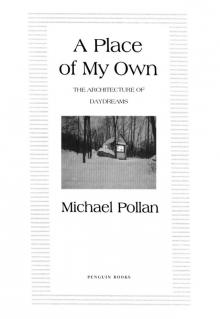 A Place of My Own: The Education of an Amateur Builder
A Place of My Own: The Education of an Amateur Builder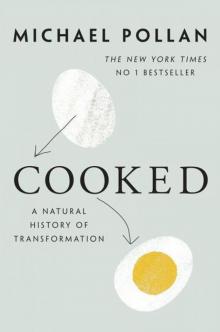 Cooked: A Natural History of Transformation
Cooked: A Natural History of Transformation The Omnivore's Dilemma
The Omnivore's Dilemma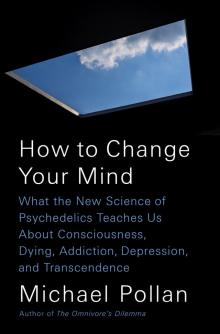 How to Change Your Mind
How to Change Your Mind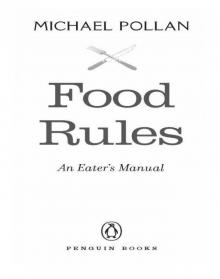 Food Rules
Food Rules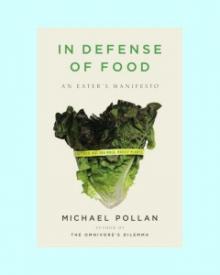 In Defense of Food
In Defense of Food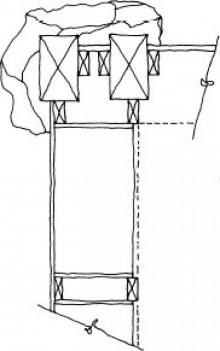 A Place of My Own
A Place of My Own